“It’s amazing how something so simple can transform how I run.”
That was my thought when I started using the PR Gear FloatRun Harness during training.
This little product won’t be for everyone because the running form cues it re-inforces may not be what you need.
But if you’re like me, hunched at a computer, stooped over a desk for most of the day, you’ll likely benefit from such a tool.
This review will be short, but that’s ok because the FloatRun Harness is super simple.
So what is the Foat Harness, and how does it work?
Affiliate Disclosure: By clicking through the links on this page and purchasing the products, you’ll be helping me out. This is done because I receive a kickback from the sellers at no extra cost to you! Thank you so much for supporting us!
I received the PR Gear FloatRun Harness at no cost from the manufacturer, but I am in no way compensated for this review.
Which minimal running shoe is for you?
Take a quick 5-question quiz to identify the perfect minimal running shoe for your feet! You'll get both road and trail options based on your answers!
It’s a super long elastic band. It’s as simple as that.
Well, technically, it’s a band with three loops—two shorter ones on either end and one larger opening in the middle.
Coming to you from the founder of Altra, PR Gear is on a mission to create simple tools to improve your running and foot health. I’ve also recently reviewed the Bridge Soles, which are helpful when transitioning into zero-drop or minimal shoes.
How do you use the FloatRun Harness?
All you have to do is put the large loop over your head and arms like you’re putting on a t-shirt and position the smaller loops by the armpits.
Then you loosely thread your thumbs through the end loops and keep your shoulders back and arms in that position, and start to run!
Don’t worry; there’s a helpful video if you can’t work this out like me! 🙂

How does the FloatRun Harness improve your running?
Because you have your thumbs through the smaller loops, it encourages you to keep your hands high and next to your ribcage, reducing arm swing down to a minimum.
Pushing your body into this more compact upper-body position should reduce excessive arm swing, keeping your body weight above your center of mass. Doing so reduces your stride length and increases your cadence, which has been shown to reduce injuries.
In addition to the lack of movement, the band is positioned from one arm around the back to the other arm, encouraging you to keep your shoulders back, reducing any hunch.
Hunching over your stride pushes your upper body weight forward, likely forcing you to counter by sitting back in your hips. This will compress your chest and diaphragm, making breathing more challenging and less efficient. And also cause a heavier footfall.
So as you can see, if you already have a flared chest with your arms far back kind of running stance, you’ll likely not benefit from the FloatRun Harness. But that’s a small minority of us.
FloatRun Harness
PrGear.co
Use Code: BRR20 for 20% off!
As with any running intervention, you must ease your way into it.
Because the FloatRun Harness is so small, you can use it at the start of your run and tuck it away in a pocket for the rest.
On my first FloatRun Harness run, I went out for a slow 10km. And I took it off after 6km.
It was truly hard for me! My upper back and triceps were fatigued! Which means I was likely letting my arms fall and swing out of position in all of my previous runs.
Now I’ve started using it on my slower, longer runs with the hope that it’ll engrain the movement pattern in my brain.
I have noticed on my other runs I am more conscious of my arm and shoulder positioning, but it’s yet to become second nature after a few weeks of occasional use.

In the packaging, along with the FloatRun Harness, comes a small set of instructions and explanations vaguely reminiscent of an electronic gadget.
The headline of the instructions note, “Elbows back, Proud Posture, Bent Knee Landing, Quick Cadence”! And then points you toward a handy web page + video instructing you how to put the FloatRun Harness on! Trust me will have to reference it! 🙂
But more important than all that is when to use it.
The instructions note that you should use the harness on “every non-speed run possible for 6 – 12 weeks”. Then, “Afterward, use once a month to tune up.”
Like me, your usage may vary due to your running habits and training plan, but I’ve attempted to use it as much as possible.
As the instructions state, “non-speed run,” it makes sense that you’re not going to take this tool to your track sessions or hill repeats.
But what about different surfaces, roads, or trails? I tested this out!
I tried the FloatRun Harness on the road/pavements, and obviously, it was the ideal environment to practice a form intervention like this. You could focus on your posture without worrying about tripping hazards or uneven surfaces.
Which Altra Shoe is for you?
Take a quick 4-question quiz to identify the perfect Altra running shoe for your feet! You'll get both road and trail options based on your answers!
I also took the FloatRun Harness out on a rocky, technical trail run (I know, not wise), and it was likely an injury hazard rather than a form improver.
When running over uneven terrain, you naturally move your arms and body from side to side to counter the undulations underfoot. Having your hands close to your ribs and attempting to keep them there continuously is likely dangerous if you fall. Or at least it is if you don’t give yourself the flexibility to counter any imbalance.
So, I’d suggest sticking to flat roads or at least buffed-out trails with the FloatRun Harness.
When I originally asked the founder of PR Gear for a pair of Bridge Soles to review (see my review post on them), he was insistent on sending the FloatRun Harness too.
Initially confused, I thought, well, why not try something new?
But now, after using the FloatRun Harness, I’m pleasantly surprised and ultimately glad he sent it to me!
Personally, this running form intervention is perfect for me, as my posture sways towards a forward hunch and rounded shoulders. So any tool that can remind me to pull my shoulders back and stay upright is a bonus!
So if that sounds like you, it could be worth a try!
It’s cheap; it’s simple, but I think the results may punch way above its unassuming positioning on the market!
FloatRun Harness
PrGear.co
Use Code: BRR20 for 20% off!



